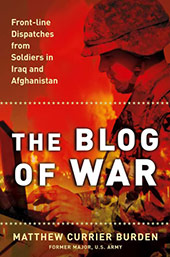intro | ch1 | ch2 | ch3 | ch4 | ch5 | ch6 | ch7 | ch8 | epilogue
Overview
One of the primary characteristics of blog writing is multivocality (Lankshear & Knobel, 2006). The active participation of multiple agents on blogs suggests that the blog as a whole must be understood as a collaboratively constructed textual production. This collaborative construction allows for the inclusion of multiple perspectives within a single text. In a similar way, Burden’s book aims to provide a variety of perspectives on the War on Terror by drawing on blog entries from military personnel (infantry soldiers as well as commanding officers), families, and friends of those soldiers. Burden provides little editorial commentary on or context for these bloggers’ entries, favoring the texts in their own original form rather than providing a lengthy explanation or analysis of them. Still, he combines blog excerpts topically and by authors--blog posts written by soldiers on combat missions are separated from those posts by doctors in base operating rooms or parents who receive notice that their sons have been injured.
Burden’s choice to organize his book chronologically serves two purposes. Fundamentally, it provides a general sequence of events evidenced within blog posts that begins with announcements of deployment and enlistment, moves through daily operations in and out of combat zones, pauses briefly to pay tribute to mortally injured soldiers, and finishes with soldiers’ homecomings and current locations and status. In this way, Burden’s organization reflects the narrative structure evident on the blogs themselves. On another level, his choice to organize the blog posts chronologically reflects the dynamics of Internet-based publishing. As Torill Mortensen (2008) noted, one of the affordances of blog publication is that it allows for a mode of publication that more closely resembles the way we structure our lived experiences in our own minds (p. 463). She stated,
This is what the weblog does to the everyday thought process. By offering a box to fill, the weblog agent asks you, “So, what was that thought you wanted to share?” Through communication and the sharing of information, we repeatedly recreate the story of our life in interaction with others….All the little bits and pieces of information can be repeatedly restructured into new paradigms, sets of understanding, or even worldviews….what the Net invites us to do is not to kill the understanding of the great modern narrative, but to open the scope of it indefinitely. (p. 464)
In ordering the compiled posts chronologically, Burden creates
his own narrative structure to the various “bits” of evidence about
soldiers’ experiences and creates cohesion across the pieces of textual
information. In this way, Burden's chronology of blog posts recontextualizes
soldiers’ experiences into his own representation of the modern day
“war story.”
